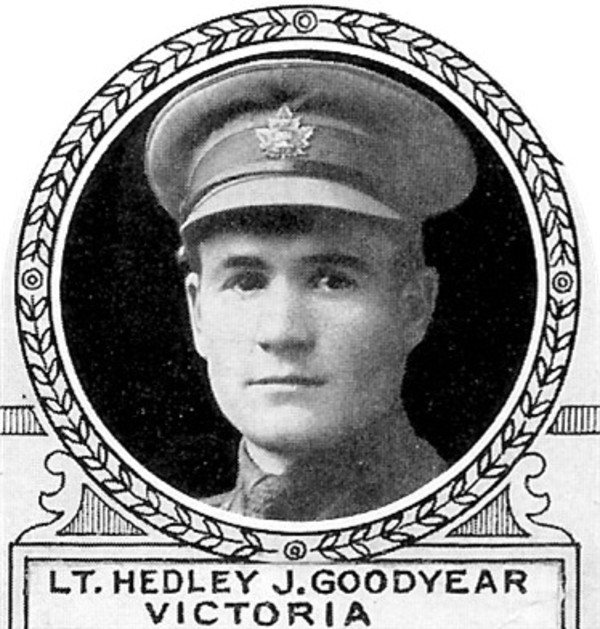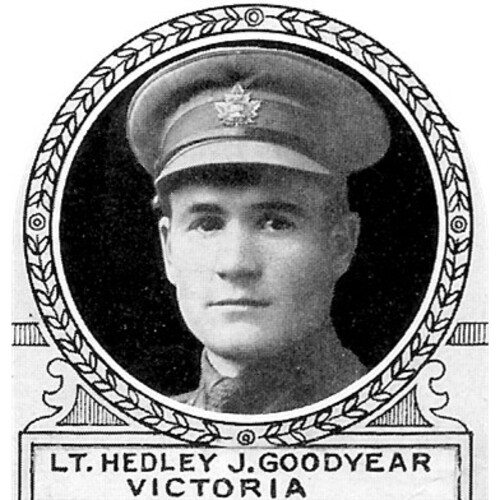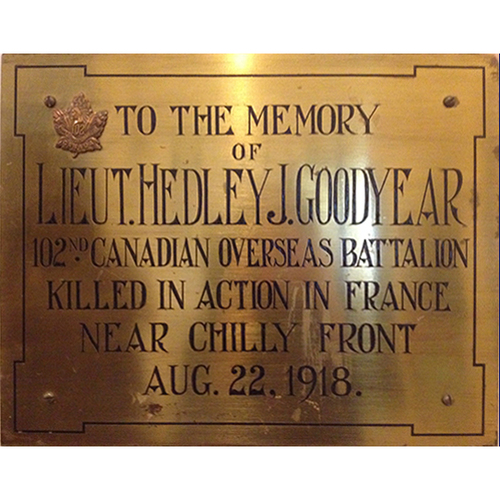
Source: Link
GOODYEAR, HEDLEY JOHN, teacher and army officer; b. 18 Aug. 1886 in Ladle Cove, Nfld, son of Josiah Goodyear, a carpenter and fisherman, and Louisa Wellon; d. unmarried 22 Aug. 1918 near Rosières-en-Santerre, France.
The third of seven children, Hedley Goodyear was born in the small outport of Ladle Cove and he attended public school there. When his family moved to the newly established pulp-and-paper town of Grand Falls in 1908, he was in attendance at the Methodist College in St John’s. The move was due largely to Louisa Goodyear’s aspirations for her children. She wished for them a future beyond the confines of an outport, and Hedley, who taught briefly in Moreton’s Harbour, seemed destined to fulfil her dream.
Tall, sandy-haired, and a keen student, he entered Victoria University in Toronto in 1909 and received his ba four years later. He studied in the faculty of education in 1914–15, earned an ma in 1915, and taught for a time at Regal Road Public School in Toronto. By then, however, World War I had intervened.
Although a Newfoundlander by nationality, Goodyear had spent a year in the Canadian Officers’ Training Corps at the University of Toronto. On 28 March 1916 he enlisted in Toronto with Canadians in the 201st Infantry Battalion, and was immediately promoted lieutenant. Transferred to the 208th Infantry Battalion in February 1917, he embarked for Britain in May; in January 1918 he joined the 8th Reserve Battalion and then, in France, the 102nd Infantry Battalion. He was awarded the Military Cross for his “conspicuous gallantry and devotion to duty” in February: he led his platoon in an attack upon a wood that was strongly defended by machine-guns, and after other officers had fallen he reorganized their platoons and led a successful charge. Goodyear survived the battle of Amiens in early August, but, having volunteered to lead a reconnaissance party back through captured trenches two weeks later, he was killed by a sniper’s bullet. He was 32 and engaged to be married to Betsy Turnbull of Hawick, Scotland.
Although Goodyear family stories indicate that Hedley had met the celebrated poet Edwin John Pratt* in Newfoundland before going to Toronto – Pratt had also taught at Moreton’s Harbour – the friendship of the fellow Newfoundlanders developed more fully at Victoria, where Pratt studied from 1908. Goodyear was a popular student, prominent in the Union Literary Society and an outstanding debater. In October 1911 he published in the school’s literary review, Acta Victoriana, a vivid account of shooting a 100-ton whale while he was home that summer.
It was Pratt who published in Acta Victoriana Goodyear’s poignant letter to his mother of 7 Aug. 1918, on the eve of Amiens; Pratt called it “The last home letter of Hedley Goodyear.” Eventually it came to be believed in Newfoundland, where the letter was frequently read at services on Armistice Day and on Memorial Day (1 July), that Goodyear had been killed the day after he wrote it. In fact, he lived to write another, less-celebrated letter home, on 17 August. Unlike his sombre farewell of the 7th, it expressed the confidence and optimism that Allied troops were beginning to feel as the war’s end became probable. “Don’t worry about me,” it concluded. “I’m Hun-proof.” Six days later the chaplain of the 102nd buried him in a British cemetery near Le Quesnel. “He was,” wrote his colonel, Frederick Lister, in a letter to his father, “an officer of whom any Battalion Commander might well feel proud.”
The short life and tragic death of Hedley Goodyear were typical of the fate of many young men whose promising futures were abruptly curtailed by the war. What impact Goodyear would have had can only be the subject of speculation. It seems likely that his influence would have been felt, certainly in his native Newfoundland. In his ma thesis, “Newfoundland and its political and commercial relation to Canada,” he argued that its future lay in a confederation with Canada. Though he never doubted his own identity as a Newfoundlander, he attacked the island’s denominational educational system as a “festering disease,” decried its poverty, economic stagnation, and low standards of health, and lamented its failure of political will and sense of imagined nationalism. At the time, however, his viewpoint was so controversial that no shopkeeper in St John’s would carry the published pamphlet based on the thesis.
Hedley’s devoted sister, Kate (Daisy), believed that he might have become a statesman, an educator, a writer, or some distinguished combination of all three. In the end he stands as a symbol of the appalling waste of war, one of three Goodyear brothers to die in the Great War. Almost 30 years after his death, when one of his nieces enrolled at the University of Toronto, a professor (Ernest Leroy Daniher) noticed she was a Goodyear from Newfoundland and asked if she was related to Hedley. She replied that he was her uncle, but that he had been killed in the war. “I know,” the professor replied. “We graduated together. He was the finest man I ever knew.”
Hedley John Goodyear’s whaling article, “Landing a hundred-tonner,” appeared in Acta Victoriana (Toronto), 35 (1911–12): 1–3, and “The last home letter of Hedley Goodyear” was issued posthumously in the same journal, 43 (1918–19): 60–61. Goodyear’s ma thesis was published in pamphlet form as Newfoundland and its political and commercial relation to Canada (Toronto, [1915]).
NA, RG 150, Acc. 1992–93/166, file 228239. Acta Victoriana, war supp. (1919): 13. David Macfarlane, The Danger Tree: memory, war, and the search for a family’s past (Toronto, 1991). Univ. of Toronto, University of Toronto roll of service, 1914–1918 (Toronto, 1921).
Cite This Article
David Macfarlane, “GOODYEAR, HEDLEY JOHN,” in Dictionary of Canadian Biography, vol. 14, University of Toronto/Université Laval, 2003–, accessed December 12, 2025, https://www.biographi.ca/en/bio/goodyear_hedley_john_14E.html.
The citation above shows the format for footnotes and endnotes according to the Chicago manual of style (16th edition). Information to be used in other citation formats:
| Permalink: | https://www.biographi.ca/en/bio/goodyear_hedley_john_14E.html |
| Author of Article: | David Macfarlane |
| Title of Article: | GOODYEAR, HEDLEY JOHN |
| Publication Name: | Dictionary of Canadian Biography, vol. 14 |
| Publisher: | University of Toronto/Université Laval |
| Year of publication: | 1998 |
| Year of revision: | 1998 |
| Access Date: | December 12, 2025 |




